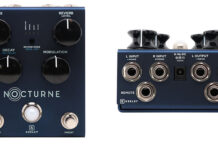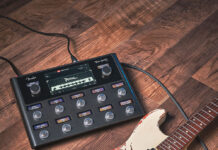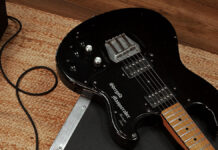
Mastering the Fretboard Using Keys and Chord Progression Roots
This is an abridged and shorter version of a lengthier article that can be found on Guitarchalk.com.
The easiest way to master the fretboard is by root note memorization, and not merely memorizing the notes of all the frets on each string. That’s a part of the process, but I want to go a step further and show you how to anchor root notes in your memory based on chord progressions.
Here’s the process I’ll follow in this guitar lesson:
1. Identify a common key.
2. Locate the most convenient fretboard positions for that root.
3. Memorize the chord progressions that expand from those roots.
Let’s start by talking about this process, and how keys, scales and chord progression roots are all connected.
The Process: Keys, Scales and Common Chord Progression Roots
Every key has a list of chords that correspond to the key’s root notes and resulting group of “common” chord progressions. For example, let’s assume we’re trying to establish ourselves on the fretboard in the key of C. We would first call to memory the C major scale, which is the following:
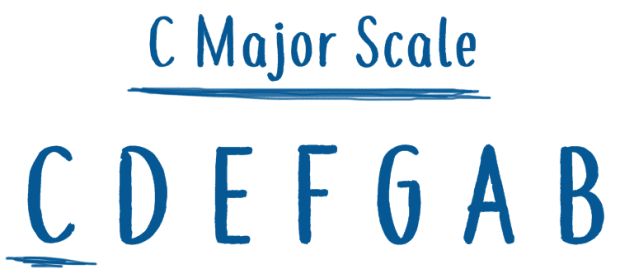
Now, consider the chords in the key of C, from these seven scale notes:

Now we can establish a few common chord progressions to “plot” the root notes on the fretboard and begin memorizing a pattern. In most scales, I, IV and V is the most common sequence of degrees, meaning the first, fourth and fifth degree of the scale provide the chords.

We should also consider I, ii and V, since that gives us C, D and G chords, which is another common guitar chord progression.

Now that we’ve established some common chord progressions in the key of C, we need to plot each chord’s root note on the fretboard, wherever they occur. I’d recommend sketching or labeling each note in a diagram like this:

Using only seven fretboard locations, we’ve established two easy structures for playing in the key of C, with one particular chord progression. These two “grids” at the third and eighths frets now provide the following context:
· Key of C
· I, IV and V chord progression
Additionally, each structure can be expanded. In the following diagram, notice the arrow connecting the two C notes on the eighth and 10th frets, as well as the third and fifth frets. We can repeat that octave spacing for the other notes in the graphic as well.

When a root note falls on either of the bottom two strings (the sixth or fifth) you can find the octave of that root by moving up two frets and two strings, allowing you to effectively double your real estate for any one progression of root notes. Thus, if you know the key, you can easily find roots, progressions and additional notes to work with.
The Memorization Process
It’s important to compartmentalize this information based on the key you’re playing in. For example, the key of C should remind you of the C, F and G chord progression, which should then remind you of the aforementioned fretboard locations. It all needs to happen in a brief moment, but is extremely helpful when you can tie it all together.
Now, obviously you won’t always be playing the same progressions, given the key of C. But, it’s going to happen a lot and if you’ve memorized where to go under those circumstances, you’ll be able to quickly think through the following:
· Key you’re playing in
· Root fretboard positions
· Chord progression roots from those positions
Even if the chord progression differs slightly, you’ll know the location of the notes in that structure, making it easier to navigate the fretboard and move to different chords or improvise some kind of melody line.
Will I have to memorize all the progressions for each key?
You should only be memorizing a few progressions for each key. As you move through keys and chord progressions, it gets easier and more intuitive than you might think. Here’s a good graph that shows a high-level view of the memorization process:
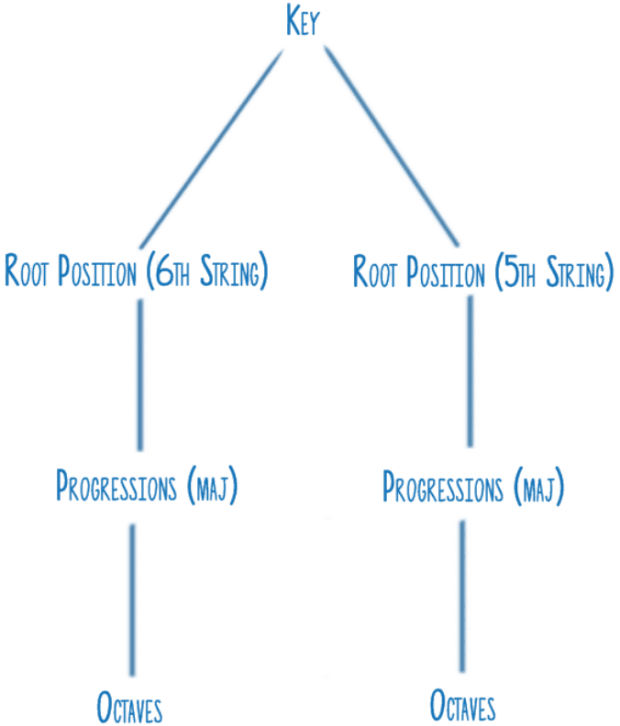
I would advise that you start memorizing progressions that you’re already familiar with and most often use in a given key. For example, the key of E commonly produces E, A and B. You probably play this progression all the time without even realizing it.
You’re going a step beyond simply memorizing them in a chronological fret-by-fret order and instead memorizing based on a pattern that you will commonly use.
If you lookup the E major scale, you’ll see that it’s the I, IV and V sequence. Take the roots of that progression and memorize their locations on the fretboard. Should you need assistance with identifying chord progressions for the key in question, I’d recommend using guitar-chords.org as a quick reference.
You can then memorize the octaves of each root in the progression.
Here’s how your graph might fill in.
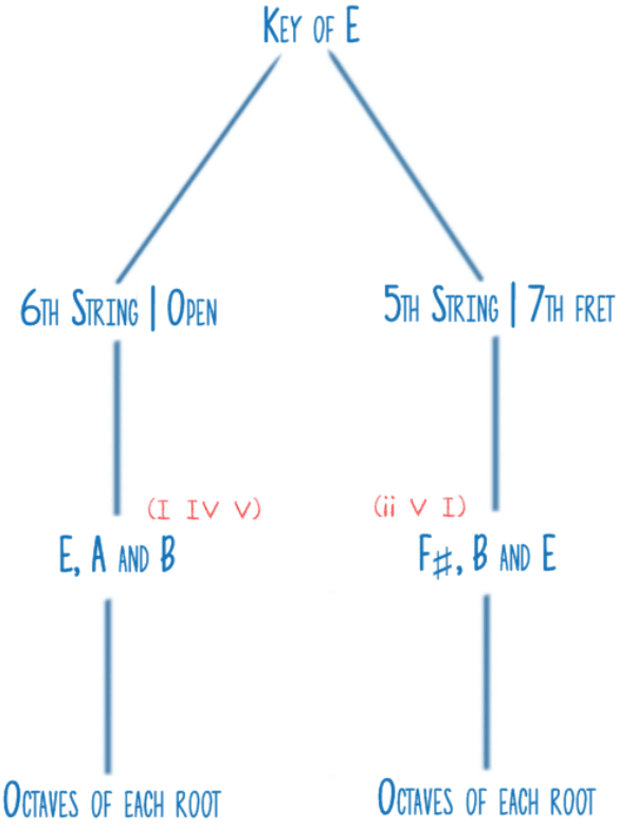
You’ll find that knowing where one note is helps you find other notes in relation to the one you already know, which is a big part of understanding this concept. You’re going a step beyond simply memorizing them in a chronological fret-by-fret order and instead memorizing based on a pattern that you will commonly use.
At that point, knowing the location of the root E will help you intuitively recall where the other notes are.
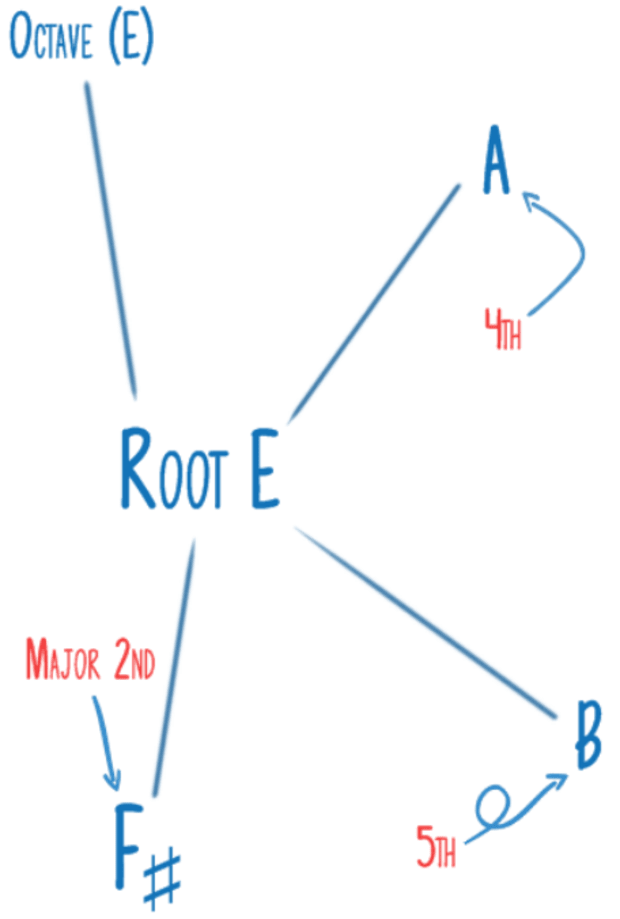
The fourth, fifth and major second tags all indicate the interval spacing from the root. Keep in mind: All these notes are pulled from the same scale, in this case the E major scale. Now that we understand the method and process, let’s work it out on some guitar tablature.
Making it Concrete: Tabs and Audio
We need to move these ideas out of the theory realm and into some practical application. Since we’ve already used the keys of C and E for our examples, I’ll use a couple different keys here to illustrate how we might implement this process on a tab sheet.
Key of D Example
We’ll start with the key of D, which positions our roots at the fifth and 10th frets. In this example we’ll only use one chord progression.
· Root Positions: Sixth String | 10th fret & Fifth String | Fifth fret
· Chord Progression: D, G and A
The root positions for the chords in our progression (D, G and A) can be tabbed on both the fifth and sixth strings:
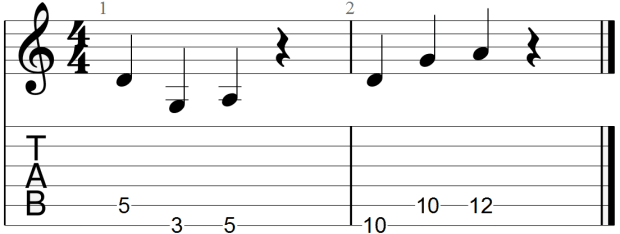
We can also add octaves above each root, which I’ve put in parenthesis to indicate a ghost note and to create a dyadic chord:
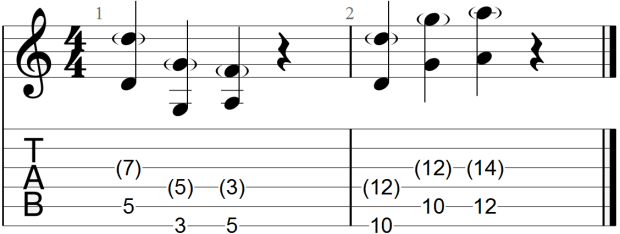
Assuming you intend to “practice” the key of D, these are the fretboard notes you’ll want to memorize, in relation to one another. As a result, you should be able to quickly recall the fretboard location of these notes if and when you’re playing in the key of D. For a simple cheat sheet, here’s the tab with each root note labeled:
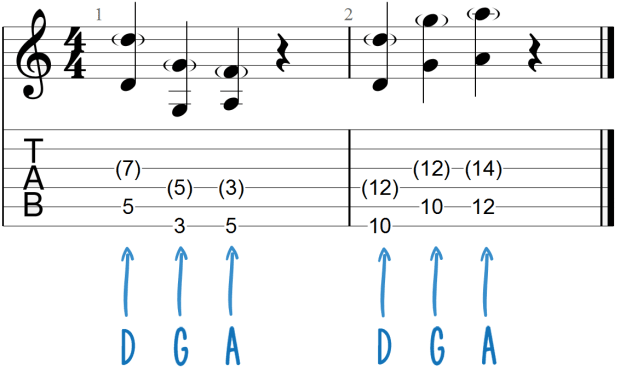
Key of A Example
Let’s repeat the process, with tabs for a chord progression in the key of A.
· Root Positions: 6th String | 5th fret & 5th String | open
· A, D, E & Bm, E, A
Notice I’m using roots from two chord progressions, where there’s some overlap with the E and A chord showing up in both. That leaves us with A, E, Bm and D, which we can plot without necessarily adhering to either progression. This leaves room for rearrangements and variances in the order they occur.
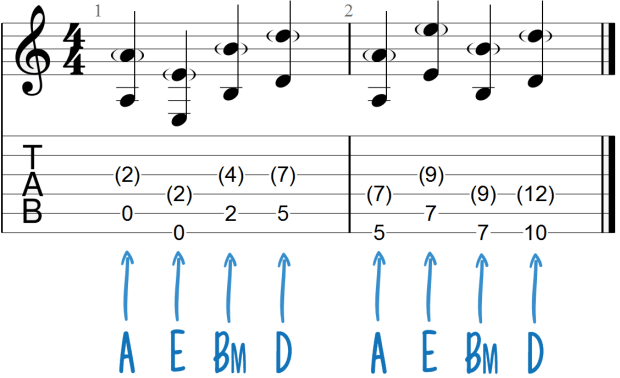
Concluding and Following Up
Keep in mind, this tactic can apply to just about any skill level, even without a prior knowledge of music theory. It’s also not something you’re likely to “master” in a short time span. Because there are always more chord progressions and fretboard structures that you can learn or memorize.
However, focusing on the most common progressions give you structures and patterns that you’ll reuse a lot.
That way you can sort of “optimize” your practice time.
Think about it this way:
If you know where the C, G and D progression falls on the fretboard, and you can move to, from and within it quickly, the time spent memorizing it will benefit you multiple times over, every time you play a G, C or D chord or any variation thereof.
Take the time to memorize the right things in the right way. As a result you’ll be a faster, more efficient guitarist and a better overall musician.
Works Cited
· “Scale Degrees.” MusicTheory.net. N.p., n.d. Web. 16 May 2017.
· Sandercoe, Justin. “How to Use Octaves.” Justin Guitar. N.p., n.d. Web. 17 May 2017.
· “Chords in the Key of C.” Chords In The Key Of C. GuitarChords.org, n.d. Web. 17 May 2017.
· “E Major.” Wikipedia. Wikimedia Foundation, 17 Apr. 2017. Web. 17 May 2017.
Bobby Kittleberger is the founder and editor of Guitar Chalk. You can get in touch with him here or via Twitter.
Source: www.guitarworld.com

